Last Updated on May 12, 2023 by brewthatcoffee
With so many coffee brewing methods, how can you know which is right for you? Here are the most popular ways to make coffee and who they appeal to.
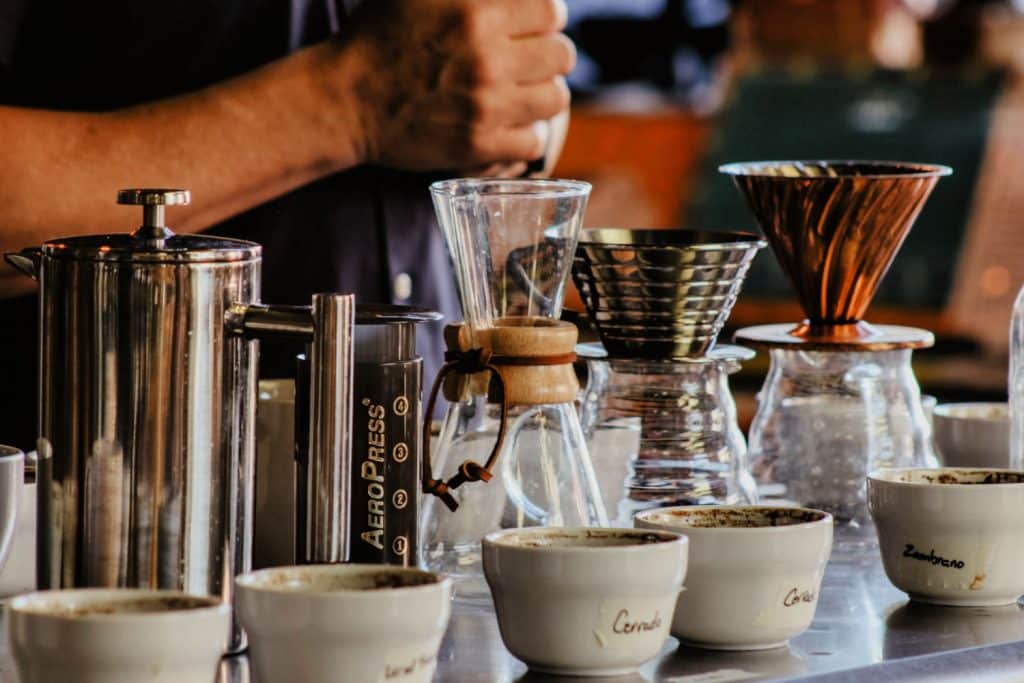
Coffee has been around for centuries, and there are a lot of ways to brew it. The thing is, everyone has their own preference of how they like to enjoy their coffee. Some prefer hot; others prefer cold. One person will like a strong, full-bodied cup while another will like a delicate and complex cup. With so many varieties and options, it can become overwhelming to choose your daily brewing method.
When trying to decide which coffee brewing method you should use, ask yourself these questions:
1) What kind of coffee do I like best-delicate, heavy, or maybe strong?
2) How much time do I have in the morning to make coffee?
3) What equipment will I need, and how much does it cost?
4) How much work am I willing to put in to make a delicious coffee?
Many factors go into deciding which way to brew your morning cup of Joe. Here is a comprehensive look at some of the best ways to brew, but keep in mind that ultimately it is a personal preference.
TLDR Guide on Best Brewing Methods
Best Method for Beginners: Keurig/Nespresso
If you are new to coffee and want a foolproof way to make your daily brew, a Keurig or Nespresso will do all the heavy lifting for you. You literally just pop a pod into the machine and press the start button.
However, if you want a quality cup of coffee, neither of these machines is the answer. Keurig/Nespresso is generally only recommended if you are in a hurry or don’t want to be bothered with the hassle of coffeemaking.
Best Method for Full-Bodied Coffee: Moka Pot/French Press
For a budget-friendly coffee that’s full of body, try the Moka pot method. This is a stovetop espresso that produces a delicious and powerful coffee.
If you want to make coffee for a crowd or would rather not turn on the stove, the French Press is a very popular brewer.
Best Method for Easy Cleanup: Single-Use Capsule Machines
Naturally, the easiest brewing method requires the least amount of parts to clean up. In a single-use capsule machine like the Keurig, you will only need to do two cleaning steps on a daily basis: add filtered water and throw out the coffee pod you used.
Best Method for the Environment: Cold Brew Coffee
Although not drinking coffee at all is the best bet for protecting the environment, we will discard that as an option.
For determining the overall environmental impact of coffee making, the number of coffee beans used, electricity consumption, water use, and waste need to be considered.
If you are concerned about the number of beans used, capsule coffee is a good option. However, capsule coffee produces a tremendous amount of waste that works against an environmentally-friendly lifestyle.
To help with the capsule waste issue, consider using refillable coffee capsules or compostable capsules.
If electricity consumption is what you would like to cut back on, cold brewing is likely the method you’ll want to try out. To make refrigeration the only electricity requirement, opt for manually grinding your coffee beans.
To make your cold brew, you can use a traditional cold brewer or an AeroPress.
Water use can be kept to a minimum by using a method that does not cause a lot of evaporation. Another thing to consider is the amount of water required to clean your brewer. An AeroPress is pretty easy to clean and only requires a little bit of rinsing.
Best Method for a Clean Taste: Chemex
The answer to this one isn’t simple, and it highly depends on your personal preference, as many coffee brewing methods produce a clean cup. Generally, pour overs will give you that clean taste.
If you are looking to make a coffee with a delicate yet complex flavor profile, Chemex is a wonderful choice. It is probably one of the ‘cleanest’ cups you’ll get due to its extra-thick paper filters.
While Chemex doesn’t produce coffee as full-bodied as a French press or as strong as a cold brew, it does deliver a crisp tasting cup of joe. Because of this, it is easy for many to identify a large variety of flavors.
Best Method for Iced Coffee: Cold Brew Maker
Cold coffee is a wonderful way to start a summer morning. If you love coffee loaded with a refreshing caffeine kick, try out the Primula Cold Brew Coffee Maker.
Best Method for Strong Coffee: French Press/Cold Brew
Strong coffee can mean two different things. Either you are looking for a strongly flavored coffee or a coffee loaded with caffeine.
If you are looking for bold flavors in your cup, a french press is sure to deliver. For an extra jolt of energy, cold brew coffee will get you going.
Steeping Methods
How the Steeping Coffee Method Works
One popular way to make coffee is by steeping it. In this method, coffee beans are ground up and soaked in water for a period of time. This can last from five minutes to even 24 hours, depending on the type of coffee you are trying to make.
Some steeping methods will require you to filter the coffee beans out, while other methods like instant coffee only need to be mixed with water.
Who This Method is For
If you love a strong, bold-tasting coffee, you will adore steeping your coffee beans.
French press

A French press is a type of coffee maker that helps you extract the soluble solids and oils from ground coffee beans by pushing them to the bottom of a container. With this method, the ground coffee will slowly become saturated with water over time. This can take up to four minutes for some types of beans, although others can take much longer.
Reasons You Might Love It: This method will suit your tastes well if you like strong coffee. In addition, it is good for anyone who doesn’t mind using a manual brewer.
Overall, the French press brews a full-bodied coffee with lots of oils due to the lack of filter.
Reasons You Might Hate it: Some people might shy away from this method because it can be difficult to clean and takes a bit of time.
The lack of a filter causes the oils to remain in your coffee, which can cause some people to experience headaches. If you are sensitive to the oil in coffee, skip the French press and maybe try a Chemex instead.
Time to Brew: Around 5 minutes once you’ve begun steeping. Keep in mind you will need to set aside time to take your equipment out and boil your water.
Grind Recommendation: Coarse
Coffee bags

A coffee bag is a small, porous bag that holds coffee grounds. They are typically made out of paper or cloth and are designed to be filled with freshly ground beans. You can also find pre-made bags that are filled with already ground beans.
Reasons You Might Love It: This method makes it easy to pack and transport coffee when you need it for work or in a hurry. If convenience is the biggest factor in choosing a brewing method, coffee bags are a wonderful option.
In addition, coffee bags are a low-mess brewing method. After you are finished using your coffee tea bag, simply toss it in the trash.
Reasons You Might Hate it: Some people find the taste of coffee made from coffee bags to be weak and inferior. Also, if you like to make coffee for a crowd, coffee bags can seem a bit wasteful than other methods.
Time to Brew: 1-3 minutes, depending on how strong you like your coffee.
Siphon brewers/Vacuum pot

A vacuum coffee maker brews coffee using two chambers where vapor pressure and gravity produce a rich, flavorful cup that you can’t get anywhere else. This type of brewer was invented by Loeff in 1834 and is often seen in ‘hipster’ coffee shops around the world- it’s also known as vacpots, siphons, and siphon.
This coffee brewing method uses a process called full immersion, which means that the coffee grounds are in constant contact with water throughout brewing.
Reasons You Might Love It: This brewer utilizes both vapor pressure and gravity to make coffee. Using both forces enables the user to create a rich, flavorful cup of coffee that is unequaled by most other brewing methods.
As an added bonus, siphon brewers make a fabulous showpiece to show off to your friends and family. It definitely looks impressive!
For anyone who wants delicious tasting coffee without sacrificing quality, then they should consider looking into siphons when they go shopping for new coffee gear.
Reasons You Might Hate it: Cleaning a vacuum pot can be an absolute nightmare. This coffee brewer has a lot of awkward curves to clean and can be easily dropped and shattered if not careful.
Also, this method takes an awkward amount of time. 10 minutes is too long for many to be waiting around and also too short to set and completely forget.
Time to Brew: 10 minutes from the start of brewing. You’ll need to set some time aside to get the equipment ready.
Grind Recommendation: Medium
Instant coffee

Instant coffee is mixed coffee that is stored in powdered form. It’s made to be mixed with water, hot or cold. Instant coffee can come in many different flavors and concentrations, depending on the brand you buy.
This method isn’t particularly popular with coffee enthusiasts. However, if you are short on time, it is a very convenient option.
Reasons You Might Love It: Instant coffee is very convenient. There are many flavors that come in instant form, so you can try different things without having to buy an entirely new bag of beans.
Instant coffee is also a low-mess brewing method for anyone who doesn’t have time for cleanup.
Reasons You Might Hate it: Some people may not like the taste of instant coffee because it’s more bitter than drip coffee. Also, some people may not be satisfied with the quality of this type of brewing method.
Time to Brew: As the name suggests, instant coffee is pretty instant. The only time you will need to put into making this cup of coffee is for heating the water, adding the mix, and stirring.
Softbrew

A Softbrew is a newer brewing method that involves boiling water and then pouring it over ground beans. The coffee brews as it travels through the grounds and finally drips out of the filter. This is considered an easy, low-maintenance way to make drip coffee.
The Softbrew method requires using a specific device that looks like a teapot. It is most similar to a French press but much easier to use. Seriously, it’s pretty much foolproof.
You can see the Sowden Softbrew here.
Reasons You Might Love It: Softbrew coffee is straightforward to make, and you get a lot of flexibility with this one as far as grind size goes. The Sowden also allows you to make cold or hot coffee. It’s also very low-maintenance and can be cleaned quickly.
Reasons You Might Hate it: Softbrew requires specialized teapot-like equipment. Some people love this unique aspect, and others find it inconvenient.
Time to Brew: 4-5 minutes.
Grind Recommendation: Any grind size that pleases you. It will all work out with this method.
Boiling Methods
How the Boiling Coffee Method Works
Boiling coffee is the traditional way of making coffee. It’s effortless and requires only something to boil your coffee in, some water, a heat source, and coffee beans. The taste typically isn’t the most sought after, but hey, it’s convenient.
Who This Method is For
The boiling method is for people who don’t mind a muddy, possibly burnt coffee. These brews are often done outside without technology, and no electric kettles, no weighing scales, and no-frills.
Cowboy coffee

Cowboy coffee was invented around 1870. This coffee brewing method is often done outdoors without any technology.
Cowboy coffee is a style of coffee that is brewed using two utensils: a pot of water and a mug. The pot will be put on the fire to boil some water, which will then be poured over the coffee grounds in the mug. If you are feeling fancy, it can be seasoned with cinnamon or some other spice.
Reasons You Might Love It: This type of coffee is perfect for people who would rather make a quick beverage without a lot of fuss. The ingredients are simple, which also makes it easy to pack and take along on a camping trip.
Perhaps best of all, this style of coffee is one of the most affordable out there!
Reasons You Might Hate it: Lack of cleanliness. The pot and mug used for this coffee brewing method will get dirty, meaning that the drinker has to be thirsty enough not to care about how their coffee tastes or smells.
Time to Brew: 2 minutes.
Grind Recommendation: Extra Coarse
Turkish coffee

Turkish coffee has been brewed for more than 400 years, and its popularity has really grown in recent years, especially in Europe. The increased amount of Turkish coffee consumption is because of the taste and convenience of its brewing method.
Turkish coffee is made with a special pot called a cezve. The pot contains a long-handled wire mesh, which is where the ground beans are added to the water. It is also often used for spiced coffee or cardamom coffee.
Reasons You Might Love It: If you have a sweet tooth and love loads of caffeine, you’ll probably enjoy a cup of Turkish coffee. Also, it’s pretty affordable to make.
Reasons You Might Hate it: This coffee tends to have a very bold flavor. Not burnt, but strong-tasting. Turkish coffee is often heavily sweetened, so maybe skip this one if sugar isn’t your thing.
Time to Brew: 10 minutes.
Grind Recommendation: Extra Fine
Dripping/Filtration Methods
How the Filtration Coffee Method Works
Filtered coffee is a type of coffee created after the steeping and filtering process. The process begins by brewing the ground coffee in hot water, then removing the grounds by pushing the water through a filter. The filter can be made out of metal mesh, paper, or cloth.
Who This Method is For
Drip coffee is created by dripping hot water slowly over grounds that are placed in a filter. The hot water filters through the filter, and the process continues until the desired amount of coffee has been made. Drip coffees are best for people who like a strong taste, less acidity, and consistent flavor.
If you enjoy a clean tasting cup of coffee, filters do wonders for that. The filters involved in the process help get rid of sediment and oils naturally inherent to coffee beans. If you are sensitive to coffee beans fats/oils, then you should find a lot of relief using this method.
Electric percolator

An electric percolator is a coffee brewing method that involves placing ground coffee in the bottom part of the apparatus, then adding water to the top. When you turn on the heat, the water will come through an electric heating element at the bottom part of the pot. The coffee grounds will eventually dissolve and make contact with the boiling water, creating brewed coffee.
Reasons You Might Love It: You love an easy-to-make cup of coffee. If you are the kind of person who enjoys going to diners in the morning and having a cup of coffee, you will get a similar coffee by using an electric percolator.
Reasons You Might Hate it: You have tremendous love and respect for the art of making coffee. The taste of your coffee is critical to you, and if your coffee tastes bad, it’s a bad day. You will go to great lengths to brew a tasty coffee.
Time to Brew: 5 minutes.
Grind Recommendation: Coarse.
Chemex

A Chemex is a coffee maker designed for brewing coffee with a filter. The design of the device filters out sediments and oils inherent to coffee beans, making it a popular choice for people who are sensitive to those substances.
Chemex was invented in 1941 by Peter Schlumbohm. He wanted to bring his love of science into the kitchen; Edouard de Limousin (a French chemist) helped him design the coffee maker.
The manual method of brewing with a pour-over device like the Chemex ensures that you have complete control over the process, which can give you more freedom in choosing your ideal extraction parameters for a specific bean or roast.
Reasons You Might Love It: The Chemex makes coffee that is light and flavorful, and it has a flavor profile that is very clean and balanced. Those who love a coffee with fully realized flavors and a sense of clarity to the taste will adore the Chemex.
Despite the unique shape of the Chemex, it is actually pretty easy to clean. Simply use a dish want to gently scrub the inside of your Chemex and then let it air dry.
Reasons You Might Hate It: If you swear by a heavy-bodied coffee with grit and oil, then Chemex could be a little too tea-like for you. Also, if you do not have the suggested cleaning wand on hand, cleaning the Chemex can be almost impossible.
There’s a lot of variability with this method, and it can be difficult to find your perfect cup if you’re not too experienced. It can also be time-consuming.
Time to Brew: 5 minutes.
Grind Recommendation: Medium-coarse.
Espro Bloom

The Espro Bloom is a pour-over method that makes 1-2 cups of coffee in around 2 minutes of brew time. It features a spiral pattern filter with over 1500 precision cut holes.
You can choose to use this brewer with or without paper filters.
Reasons You Might Love It: This coffee maker gives you the option to reduce your waste by forgoing the filter. However, if you love filters and want to keep pesky oils out, you also have that option.
Reasons You Might Hate It: If you choose to reduce waste with the no filter method, you might have a bit of cleaning up to do at the end.
Time to Brew: 2 minutes.
Grind Recommendation: Fine.
April Brewer

The April brewer is a pour-over cup that aims to provide coffee drinkers with a reliable and balanced coffee experience. This particular brewer received the highest possible score in the World Brewers Cup.
Reasons You Might Love It: If you love a coffee brewer that isn’t prone to error, you’ll enjoy the easiness of this method.
Reasons You Might Hate it: Some describe the coffee produced by this maker as pretty good, but not the best coffee they’ve ever tried.
Time to Brew: 3 minutes.
Grind Recommendation: Medium.
Fellow Stagg X

Pour-over is hard to do, but people will go nuts for it if you make the perfect one. The Fellow Stagg X is a flat-bottomed dripper with a hole and bump pattern that ensures no clogging. Add the ratio aid to your coffee, and let the steep slope help create the best environment for brewing. There are two sizes available for pour-over brewers, so you have more options.
Reasons You Might Love It: If you struggle in the coffee to water ratio department, this will be your coffee savior. No scale? It’s not needed with this brewer.
Reasons You Might Hate it: Have a lot of coffee drinkers in your household? The largest size of this brewer only produces up to 20 oz of coffee. You’ll have to make more than one batch.
Time to Brew: 3 minutes.
Grind Recommendation: Medium-fine.
Origami
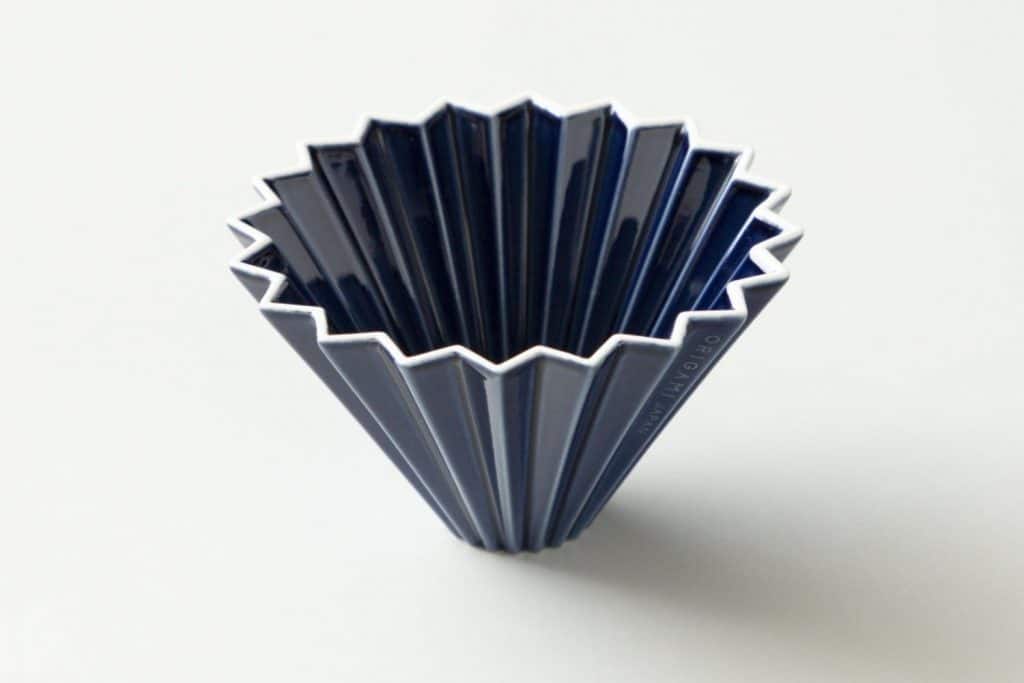
This dripper is made of ceramic and was designed in Japan. It has 20 channels that allow you to use both Kalita Wave and V60 filter paper. It gives full control over the flow rate. The designer chose not to include a handle on the dripper because it often gets in the way when someone pours coffee from it.
Reasons You Might Love It: If temperature control is an issue for you, the Origami brewer is great at preventing heat loss.
Also, this coffee brewer comes with an incredible selection of colors. If you like a little color in your kitchen, you will be drooling over all the color options!
Reasons You Might Hate it: Although this brewer is intentionally designed without a handle to aid in the brewing process, you might prefer to have it.
Time to Brew: 2 minutes.
Grind Recommendation: Medium-fine. You will want to play with your grinder settings on this one. Some people have said that this brewer allows them to go finer than they normally would with the Kalita Wave and Hario V60.
Cafec Flower

What’s not to like about a coffee dripper that resembles a flower? This Cafec Flower dripper is an aesthetically pleasing coffee dripper that makes a tasty cup.
The Cafec flower comes from Japan and uses traditional Japanese Arita ware techniques. When brewing with this method, you will want a fast and smooth pour.
Reasons You Might Love It: The Cafec Flower
Reasons You Might Hate it:
Time to Brew: 3 minutes.
Grind Recommendation: Medium.
Hsiao 50 Ceramic Dripper

The Hsiao 50 degree is a ceramic pour-over dripper that encourages its brewers to experiment a little. It is advertised as a fun way to bring out different flavors from your coffee beans that you otherwise wouldn’t taste. This translates into a lot of grind testing.
Reasons You Might Love It: If you have a lot of coffee brewing experience under your belt and would like a solid dripper for playing around, give this one a try.
Reasons You Might Hate it: New to coffee and want something more beginner-friendly? This dripper might not be as clear-cut as you’d like. If you want a brewing method with easy-to-find, tried, and true techniques, try another dripper.
Time to Brew: 5 minutes.
Grind Recommendation: Experiment with this dripper.
Clever Dripper
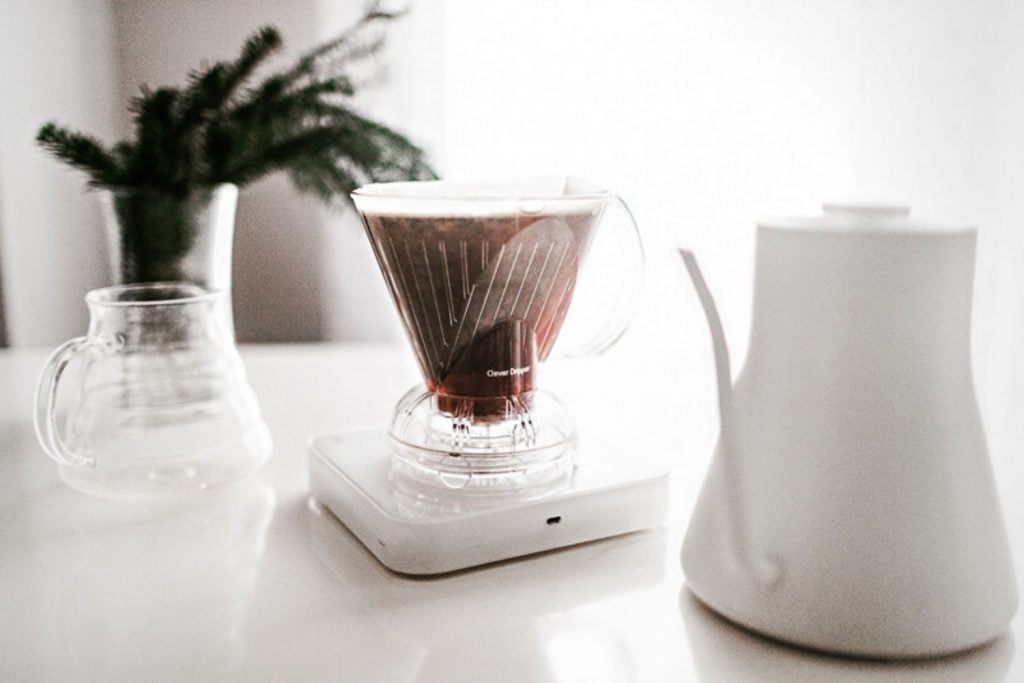
The Clever Dripper is a coffee brewing method that can be described as a steeping/dripper hybrid. The brewed coffee comes out of an opening in the middle of the device after it has run through the filter.
Many people identify this device as a pour-over coffee maker, but it actually has a few features that make it different from other drip methods. The first feature is that there is a stopper located at the bottom of the chamber that keeps the coffee from leaving the Clever Dripper until you are ready.
Second, instead of pouring water over your coffee beans, you will actually want to add your water first. Since there is a stopper, you don’t have to worry about losing your hot water. By pouring your coffee beans on top of the water, you reduce the chance of clogs and uneven bean extraction.
Reasons You Might Love It: The Clever Dripper is incredibly easy to use and is great for those who are new to pour-over coffee styles.
Reasons You Might Hate it: Some people complain about the Clever Dripper having trouble staying upright, but this can be fixed by using a different filter than the one that comes with it.
Time to Brew: 3-4 minutes.
Grind Recommendation: Medium-coarse.
Auto-drip machines

Auto drip machines are one of the most popular methods of brewing coffee in America. Auto drip machines make it easy to make a cup of coffee by simply adding hot water and ground coffee to the machine and activating a lever or push button. The water is delivered through a filter to the pot, through a showerhead-like device with small holes, and finally into your waiting mug below.
Reasons You Might Love It: Auto-drip coffee machines are straightforward to use and budget-friendly.
Reasons You Might Hate it: Auto-drip coffee is usually dull and boring in flavor, not to mention generally lower quality than other methods of brewing coffee. Auto-drips also tend to be very inconsistent in texture and taste from batch to batch. It can be difficult to make a truly decent cup of coffee with an auto-drip machine.
Time to Brew: 5-15 minutes.
Grind Recommendation: Medium-coarse.
Kalita Wave
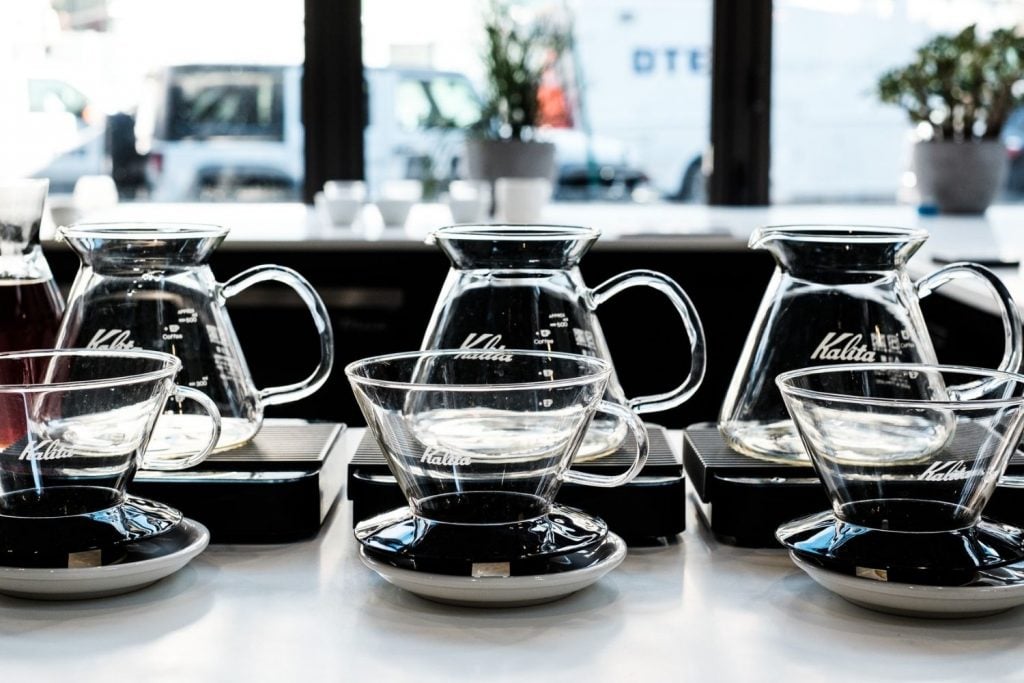
The Kalita Wave is another form of pour-over coffee. Pour-over coffee is a brewing method that relies on manual pouring to drip hot water over ground coffee. Pour-over coffee pots are usually made of ceramic, glass, or metal and can be used with paper filters, e.g., Chemex filters, cloth filters, or permanent mesh filters.
Many compare the Kalita Wave brewing system to the Hario V60, and the main difference is that the Kalita Wave has a flat filter bottom while the Hario has a cone shape. As a result, the Kalita Wave is easier to work with and leaves less room for mistakes.
Reasons You Might Love It: Pour overs brew a delicate and complex cup of coffee. The manual process is a good way to go deeper and learn more about how each variable affects the drink in your hand.
Reasons You Might Hate it: In addition, making a great-tasting pour-over coffee takes practice. If you want a brewing process that is difficult to mess up, this isn’t it. Water temperature, grind size, brew time, and even bean saturation are crucial to properly executing the pour-over.
Time to Brew: 4 minutes.
Grind Recommendation: Medium-fine.
Hario V60
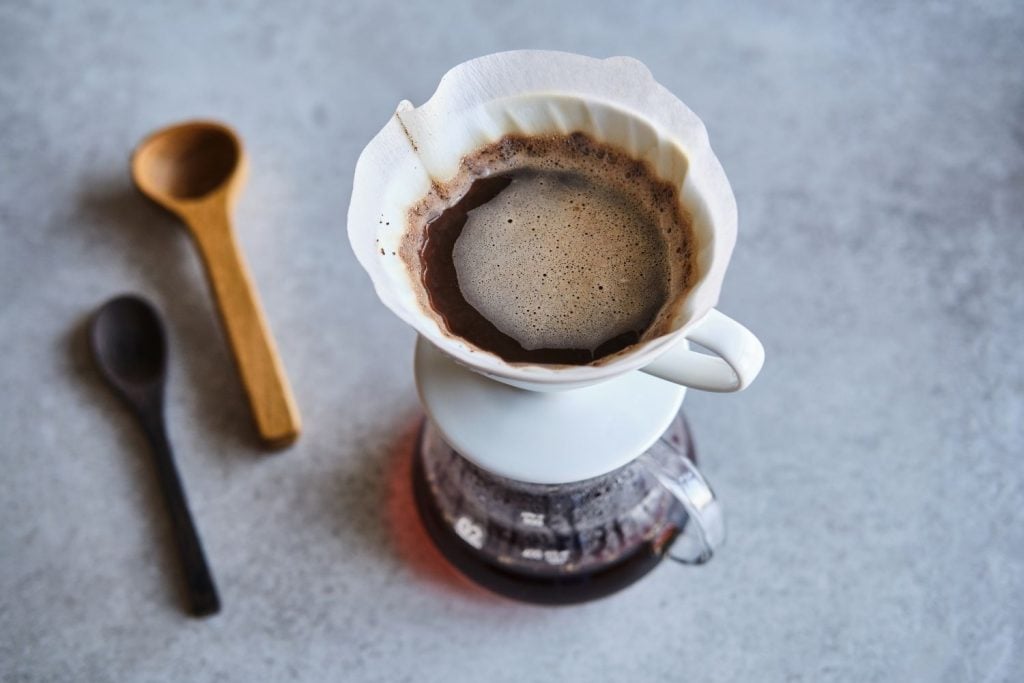
The Hario V60 is definitely an all-time favorite for many coffee enthusiasts. This Japanese pour-over coffee maker is made from ceramic to ensure an even brewing temperature. Many love using the Hario V60 for its ability to produce a balanced and clean cup of coffee.
Reasons You Might Love It: If you love fruity and floral notes, the Haro V60 does a great job of highlighting these flavors.
Reasons You Might Hate It: Like many pour-overs, the Hario V60 isn’t beginner-friendly. However, if you learn to master it, you will make some of the best cups of coffee any home barista could hope to brew.
Time to Brew: 3 minutes.
Grind Recommendation: Medium-fine.
Pressure Methods
How the Pressure Coffee Method Works
Pressure coffee brewing involves using pressure for fast extraction times. The most commonly thought of device that uses pressure is the espresso machine. However, there is a simpler and more affordable way to create this type of pressure without needing a special machine: the AeroPress or the Moka pot.
Who This Method is For
Coffee brewed with pressure is best suited for those who want to brew coffee that is as strong and bold as possible. It works for all budgets, from small (AeroPress and Moka pot) to large (high-end espresso machines).
Espresso machines
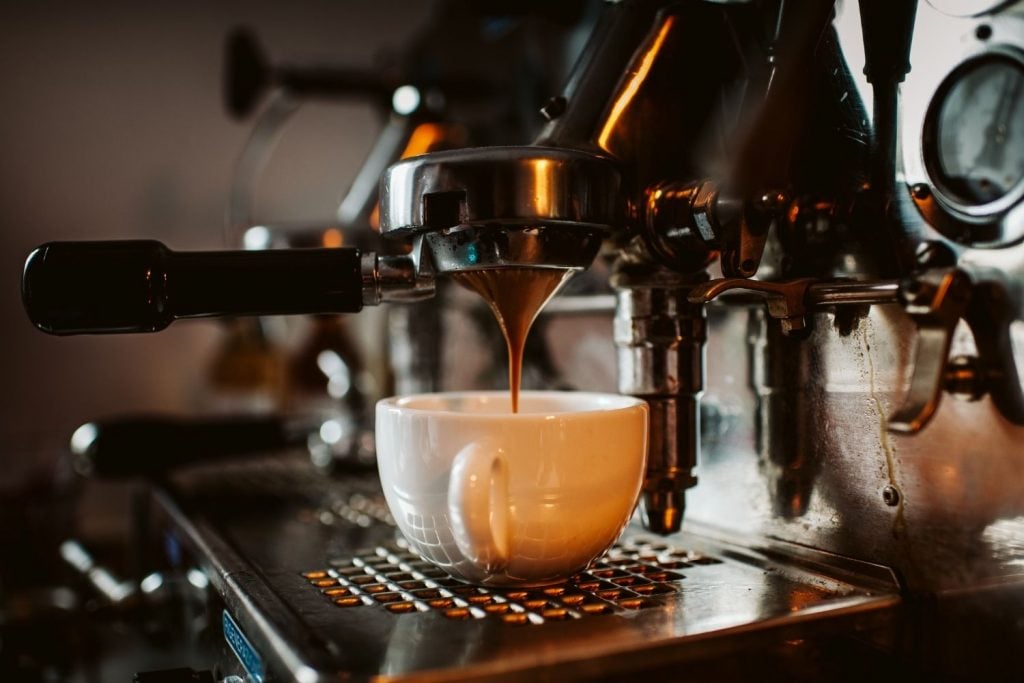
An espresso machine is a device that makes coffee by forcing boiling water at high pressure through a metal enclosure containing ground coffee.
Ever wonder what makes espresso so different from other cups of coffee? It’s all in the technique employed to extract flavor from the grinds.
When making espresso, there are two types of pressure being applied: pressure due to the pump and air being trapped in the boiler tank (known as “liquid” or “pneumatic” pressure) and atmospheric pressure created when steam fills the boiler (also called “barometric” or “atmospheric” pressure).
The result is intense, full-bodied flavor with crema, texture like thick velvet paint, and aromatic masterpieces that smell fantastic brewing.
Reasons You Might Love It: If you love a bold flavor with a thick consistency, the espresso machine is right up your alley.
Do you enjoy tinkering with fancy gadgets to get the perfect brew? You’ll be in heaven!
Reasons You Might Hate it: It takes a lot of time and patience to perfect the craft. It is also costly to purchase a quality espresso machine.
Time to Brew: 30 seconds.
Grind Recommendation: Fine.
Moka pot

A Moka pot is a simple stovetop coffee maker that can brew espresso-style coffee. It’s popular in European kitchens because it often makes better-flavored cups of coffee than the traditional drip machine.
The origins of the Moka pot are not well-documented, but it is speculated that it was invented in the 1930s by Alfonso Bialetti.
Reasons You Might Love It: There is no need to purchase expensive and complicated machines. If you enjoy the taste of espresso and want to get as close to it as possible without overspending, the Moka pot is your answer.
Reasons You Might Hate it: Cons of the Moka pot are that you cannot make many cups of coffee at once. You also need to be careful not to overfill the water, which can cause it to spill over and burn your skin or make a mess on your stovetop.
Time to Brew: 5 minutes.
Grind Recommendation: Fine.
AeroPress

The AeroPress is a coffee maker that uses pressure to extract flavor from ground coffee.
It’s actually quite simple–just put the desired amount of ground coffee in the chamber, add hot water, and press down on it to make coffee! The mesh filter lets you enjoy all the flavorful oils while trapping sediments for a clean pour.
Reasons You Might Love It: If you love a coffee brewing method that produces high-quality coffee in minimal time, the AeroPress might be right for you. It also happens to be one of the best coffee-making methods that you can take on your camping trip.
Reasons You Might Hate It: If you like to enjoy a large number of cups before having to clean and recharge your brewer, the AeroPress may not be for you.
Time to Brew: 60 seconds.
Grind Recommendation: Medium-fine.
Beehouse Dripper

A beehouse dripper is a Japanese pour-over brewer. The Bee House Dripper is loved by both interior design fanatics and coffee lovers due to its functional and adorable design.
Overall, it is a forgiving dripper that you should try if you’re a beginner, and it’s even easier to use than the Kalita Wave.
Reasons You Might Love It: This dripper is the perfect option for you if you enjoy brewing coffee more than cleaning up after. It easily brews a delicious coffee without much fuss.
Reasons You Might Hate It: If you like a more involved style of brewing coffee, this one may be too simple for you.
Time to Brew: 3 minutes.
Grind Recommendations: Medium-fine.
Cold Coffee Brewing Methods
How Cold Coffee Works
Just like you would expect, cold coffee is chilled coffee. Whether that means it was brewed using cold water or made using hot coffee and made cold by adding ice.
Who This Method is For
Cold coffee is best for people who want a refreshing coffee beverage with low acidity. Many people prefer to drink their cold coffees during the Spring and Summertime when temperatures outside are warm enough.
Chilled coffee lends itself well to planners. If you like to figure out what you are drinking ahead of time, you will enjoy timing the brew of your morning coffee to perfection.
Iced Coffee

Iced coffee is a drink that is made by brewing coffee and pouring it over ice cubes. It’s usually sweetened and contains milk and other flavors like vanilla, caramel, or hazelnut.
Reasons You Might Love It: You want a cold coffee but do not want to deal with waiting a minimum of 12 hours to get it. Your schedule is unstable and requires you to have a more convenient coffee.
Reasons You Might Hate it: Iced coffee isn’t as strong nor tastes as good as a cold brew, and this is due to the watered-down effect from the ice melting in your drink.
Time to Brew: 3-5 minutes.
Grind Recommendation: Medium-fine.
Coldbrew coffee (Immersion)

Cold brew coffee is a brewing process that features cold water and ground beans. The steeping time for this type of coffee can last anywhere from 12 to 24 hours, and it does not require any heating.
Reasons You Might Love It: If you are sensitive to the acidity in coffee, then the cold brew has a lot to offer.
The acidity in hot brewed coffee is much higher, which can cause your stomach to feel uncomfortable. This often leads people to experience heartburn, indigestion, reflux, or nausea after drinking their morning cup of joe.
Cold brew coffee has much lower acidity when compared to normal hot-brewed coffee. This makes it a better choice when you are having digestive problems.
Reasons You Might Hate it: Love to start your day with a warm and cozy drink? Cold-brew might not be the right coffee style for you then. Just as you’d expect, cold brew coffee is served chilled.
Depending on whether you prefer more or less caffeine will determine whether this will be a pro or con for you. Cold-brew coffee can have a higher caffeine content than normal drip coffee.
This is because the steeping process for this type of coffee removes more of the water from the ground beans. The higher concentration of coffee in your cup means you will experience the effects of the caffeine sooner and stronger.
Time to Brew: 12-24 hours. Although cold brew coffee is very easy to make, it does require quite a bit of time. Make sure to time your brewing right. If you want to have your coffee in the morning, I recommend getting your cold brew set up in the fridge the morning before.
Grind Recommendation: Extra Coarse
Coldbrew coffee (Slow Drip)

Cold drip coffee is a unique way of brewing coffee that is becoming more popular. It is the alternative to using the cold brew immersion method. Instead of steeping your coffee grounds for 12-24 hours, you are dripping cold water through coffee beans over a similar period of time.
Reasons You Might Love It: The cold brew process produces an exceptionally smooth cup of coffee that has low acidity and is very easy on your stomach. Cold drip coffee can also be sweetened or flavored with milk or flavored syrups.
Reasons You Might Hate it: Cold drip coffee takes a very long time to produce, which can make it inconvenient if you don’t like to plan ahead. Also, if you like to start your mornings with a cozy, warm cup of joe, this ain’t it.
Time to Brew: 12-24 hours.
Grind Recommendation: Extra coarse.
Less Commonly Known Ways to Brew Coffee
Here are some interesting coffee makers that you’re less likely to see in someone’s kitchen. These are great options if you already have the most popular coffee brewers and would like to try something new.
Vietnamese Phin

Vietnamese Phin is a small, handheld filter for brewing Vietnamese coffee. It has a metal mesh on the bottom and a pouring spout on the top.
To make coffee, you simply put your desired ground coffee inside the filter, pour hot water over it, wait for the bubbling to stop to let out any remaining gases or “sludge” that might be in the coffee, then pull up the metallic filter that was filled with brewed coffee.
Reasons You Might Love It: If you drink your coffee by yourself and want a low-fuss brewing experience, you’ll enjoy the Vietnamese Phin quite a bit. It also happens to be great for making iced coffee.
Reasons You Might Hate it: Prefer to drink your coffee with friends? Maybe another method then!
Time to Brew: A few minutes.
Grind Recommendation: Coarse.
Nitrous coffee
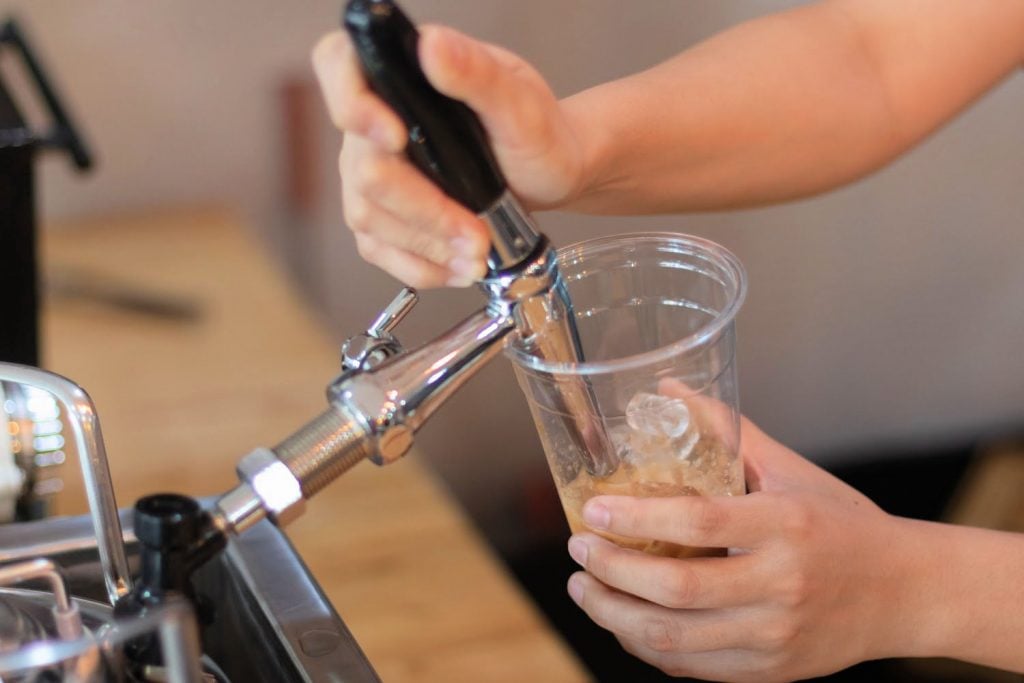
Nitrous coffee is a drink that combines cold-brewed coffee with nitrous oxide, which gives it the most lovely finish.
You can often find this type of coffee on tap (yes, like a bar tap) at modern/hipster coffee shops. It’s quite delicious!
Reasons You Might Love It: If you love the coffee shop experience or if you are looking for something fun to do with your friends, nitrous coffee might be right up your alley.
This type of coffee truly has a unique texture that must be experienced to understand.
Reasons You Might Hate It: If you want to bring the coffee shop experience home, you will need some costly equipment to get started.
Time to Brew: Same as the cold brew. 12-24 hours.
Grind Recommendation: Extra coarse.
Nel Drip

The Nel drip coffee method uses a cloth filter as opposed to paper. It produces thick and sweet-tasting coffee.
Reasons You Might Love It: If you like strong, sweet coffee that is easy to make, the Nel Drip might be right for you.
Reasons You Might Hate it: The Nel drip requires more coffee beans to be used than average. If you don’t like to waste coffee, avoid this brewing method.
Time to Brew: 3-4 minutes.
Grind Recommendation: Coarse.
Delter Press

The Delter Press has to be one of the more controversial brewing methods. It is often compared to AeroPress but has a little difference in execution. With the Delter Press, you’ll be doing what they call an ‘injection’ style brewing. This device is meant to be very portable; however, this may be easier said than done.
Reasons You Might Love It: If you are looking to try a new method just for the heck of it, give this a try. Some people swear by the quality of coffee this little brewer makes.
Reasons You Might Hate it: You’ll notice people remarking on the poor execution of this product. It is often called a bad version of the AeroPress. It isn’t easy to clean, and many people burn themselves using it.
Time to Brew: 1-2 minutes.
Grind Recommendation: Medium.
Jebena

A jebena is a beautiful ceramic coffee brewer used in Ethiopia. Drinking coffee from one of these is often accompanied by a traditional ceremony. Coffee is immersed in the jebena at just below boiling point and left to settle at the bottom before serving.
Reasons You Might Love It: You love trying out old-school methods of brewing coffee. This coffee is strong, so if you want that big flavor, you’ll get it with the Jebena.
Reasons You Might Hate it: Complicated cleanup isn’t your thing.
Time to Brew: 5 minutes.
Grind Recommendation: Fine.
Basic Coffee Making Supplies
For many of the methods mentioned above, you will need the following supplies:
Paper filters
Two main types of coffee filters are typically used. The first is a variety of metal mesh. The second type is paper filtered.
A filter is mainly used to remove the grinds from a cup of coffee. Ideally, it does not affect the taste or aroma of the coffee.
Gooseneck water kettle
A gooseneck is a thin, curved spout attached to the base of a coffee pot.
It is usually used to pour hot water over coffee grounds or tea leaves.
Using an electric gooseneck water kettle will be the most convenient as you can set the water temperature. With a regular water kettle, you will need to get a separate cooking thermometer to check the temperature.
Kitchen scale
A kitchen scale is a kitchen appliance that measures weight. A common type of scale measures the weight of an object in grams and ounces, and sometimes kilograms and pounds.
Coffee beans
Using high-quality coffee beans will always be one of the most important factors for how your coffee turns out.
Coffee grinder
You have three main options here-a manual coffee grinder, a burr coffee grinder, and a blade coffee grinder.
Manual Coffee Grinder:
You may be wondering why on Earth I would want to grind my coffee beans by hand?
A manual coffee grinder is an excellent choice if you are looking to save money and are willing to put in a little elbow grease.
Those who are only grinding coffee for themselves might take pleasure in manually grinding their own coffee beans. This is especially true if they are grinding on the coarser side.
Conversely, those making coffee for a group or grinding their beans very fine will likely find this process frustrating. This type of grinder can take forever. While it may seem fun at first, the appeal quickly fades if you are a daily coffee drinker.
Camping enthusiasts will find manual coffee grinders to be extremely convenient as they are easy to take on the go. These grinders are light and will easily fit inside your backpack.
Burr Coffee Grinder:
Burr is typically the most recommended type of coffee grinder. The burr grinder grinds up coffee beans by crushing the beans against a surface with a wheel.
What makes this kind of grinder so great is the ability to specify the size you want your coffee grounds to be. These grinders produce much more uniform results, helping with coffee bean extraction.
Burr grinders fit into two categories: a wheel burr grinder and a conical burr grinder.
The wheel burr grinder is the more economical option of the two. These grinders can be a bit messy and loud compared to conical grinders. However, many will agree that the cost savings makes up for it.
The conical burr grinder is the way to go if the price isn’t a factor and you are looking for the best possible quality. These grinders will be quieter, cleaner, and less prone to clogging.
Blade Coffee Grinder:
A blade grinder uses a blade to cut up the coffee beans into smaller pieces. Your grind size will depend on how long you leave the blade running. The longer you grind, the smaller your coffee grounds will be.
People who choose to get a blade grinder usually want to cut costs on their coffee setup.
The downsides of using a blade grinder are the build-up of heat, the noise level, and the uneven coffee grounds it produces.
Heat build-up can work against your coffee as it impacts the flavor. The noise level may bother some people as it is quite loud. As for the grounds, it is important to have uniform grounds for even extraction.
Coffee Brewing Tips & Tricks
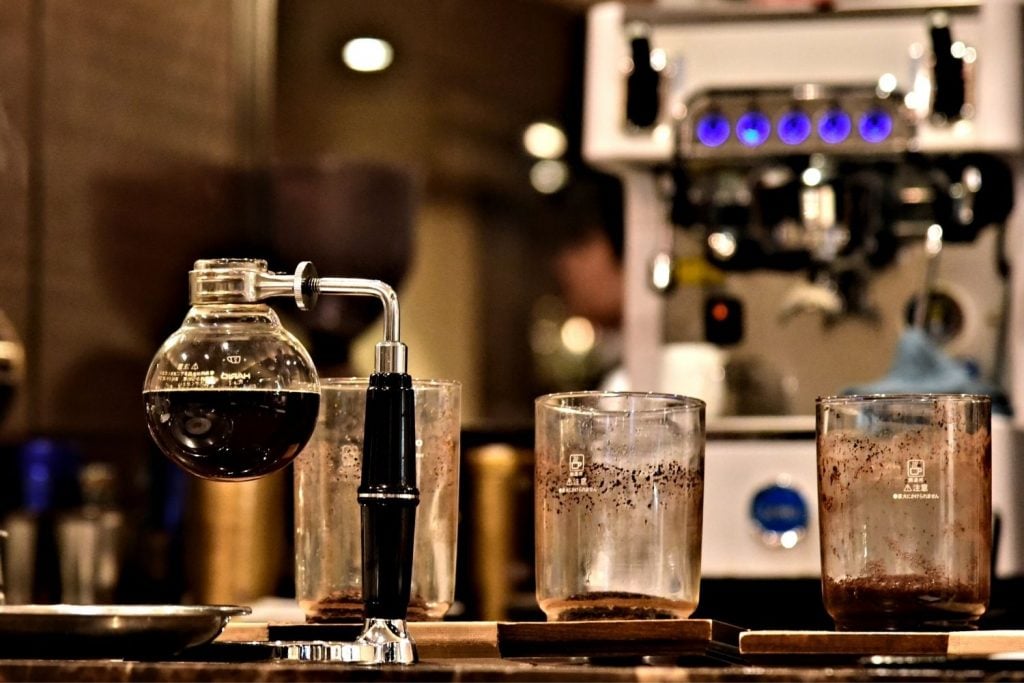
For Fresh Coffee
Buying from local coffee roasters is a great way to find fresh coffee beans. Make sure to ask your roaster about how often they roast their beans so you can time your purchases.
Learn the Rules Before Breaking Them
Before experimenting, try general grind recommendations for your brewing method first. That way, you can figure out whether you want to go finer or coarser with your grind.
Accurately Measure
Knowing things like your coffee bean to water ratio and water temperature will help you tune in on your perfect cup routine. Try changing only one variable at a time to see how it impacts your coffee.
Try Before You Buy
Before purchasing a brewer, try out the different methods at your local shop. This will help save you money in the long run.
Frequently Asked Questions:
Final Thoughts
Brewing coffee is such a fun hobby that you can really get creative with. There are so many types of brewers to experiment with and so little time! Take the time to explore all your options and find a brewer that works well for you. If you can’t make up your mind, try them all!
I hope you enjoyed this article. If you have a favorite brewing method that hasn’t been listed here, please share it in the comments. Thanks for reading.